
Eremophila divaricata, also known as spreading emu bush, is a flowering plant in the figwort family, Scrophulariaceae and is endemic to Australia. It is a shrub with stiff, spreading, tangled branches which are often spiny on their ends, erect leaves and mauve to lilac-coloured flowers.

Howittia is a genus of plant containing the single species, Howittia trilocularis, commonly known as blue howittia, and is endemic to Australia. It is a tall shrub found growing in shaded valleys and on rainforest edges, it has hairy leaves and single, purple flowers.

Lasiopetalum behrii, commonly known as the pink velvet bush, is a species of flowering plant in the family Malvaceae and is endemic to southern continental Australia. It is an erect shrub with lance-shaped, narrowly oblong to narrowly elliptic leaves and groups of white to pink and reddish-brown flowers.
Kunzea peduncularis, commonly known as mountain burgan, is a flowering plant in Myrtaceae, the myrtle family, and is endemic to Victoria, Australia. It is usually a dense shrub and has lance-shaped to egg-shaped leaves with the narrower end towards the base. Dense groups of white flowers appear in early summer.
Trochocarpa clarkei, commonly known as lilac berry, is a rare flowering plant in the family Ericaceae. It is endemic to sub-alpine areas of Victoria in Australia. It is a shrub which grows to around 30 cm high. The flowers are maroon with a greenish base. The fruits, which appear in autumn, are about 8 mm in diameter. These are eaten by small mammals and birds. The species occurs in subalpine areas of the southern highlands, often in association with Eucalyptus pauciflora.

Lasiopetalum ferrugineum, commonly known as rusty velvet-bush, is a species of flowering plant in the mallow family and is endemic to eastern Australia. Growing up to a metre tall, much of the plant is covered in rusty hairs. It is found in forest and heathland.

Lasiopetalum macrophyllum, commonly known as shrubby velvet bush, is a species of flowering plant in the family Malvaceae and is endemic to south-eastern Australia. It is a shrub with egg-shaped to lance-shaped with rust-coloured hairs on the lower surface, and woolly-hairy, cream-coloured and reddish flowers.

Lasiopetalum baueri, commonly known as slender velvet bush, is a species of flowering plant in the family Malvaceae and is endemic to south-eastern Australia. It is a small, greyish shrub with more or less linear to narrowly oblong or narrowly elliptic leaves and groups of white or pink flowers.
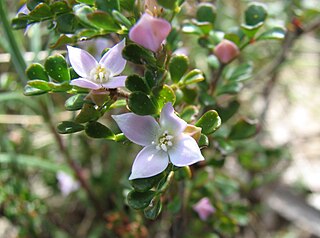
Boronia algida, commonly known as alpine boronia, is a flowering plant in the citrus family, Rutaceae and is endemic to south-eastern Australia. It is an erect shrub with many branches, pinnate leaves and white to bright pink, four-petalled flowers usually borne singly on the ends of branches.

Podolobium procumbens, commonly known as trailing shaggy-pea, trailing podolobium or trailing oxylobium, is a flowering plant in the family Fabaceae and is endemic to south-eastern Australia. It is a trailing small shrub with oval-shaped leaves and orange pea-like flowers.

Pultenaea densifolia, commonly known as dense-leaved bush-pea, is a species of flowering plant in the family Fabaceae and is endemic to southern continental Australia. It is a spreading or low-lying shrub with broadly egg-shaped, down-curved leaves and clusters of purple or yellow, red and purple flowers.
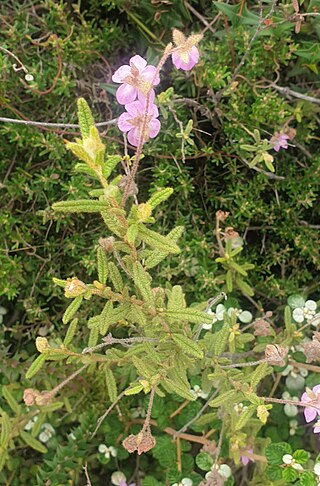
Thomasia petalocalyx, commonly known as paper flower, is a species of flowering plant in the family Malvaceae and is endemic to southern Australia. It is a shrub with wrinkled, oblong to egg-shaped leaves and cup-shaped mauve flowers.
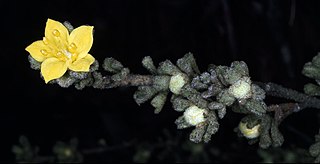
Asterolasia phebalioides, commonly known as downy starbush, is a species of shrub in the family Rutaceae and is endemic to south-eastern continental Australia. It has densely crowded heart-shaped to wedge-shaped leaves densely covered with star-shaped hairs, and single yellow flowers borne on the ends of branchlets with star-shaped hairs on the back of the petals.

Pultenaea canaliculata, commonly known as coast bush-pea, is a species of flowering plant in the family Fabaceae and is endemic to coastal areas of southern continental Australia. It is an rigid, spreading shrub with hairy, cylindrical leaves, and yellow and crimson flowers.

Pultenaea subalpina, commonly known as rosy bush-pea, is a species of flowering plant in the family Fabaceae and is endemic to a restricted area of Victoria. It is a rigid, prostrate to erect or spreading shrub with linear leaves and pink, pea-like flowers.

Lasiopetalum bracteatum, commonly known as Helena velvet bush, is a species of flowering plant in the family Malvaceae and is endemic to the south-west Western Australia. It is an erect, spreading shrub with egg-shaped leaves and loose groups pinkish flowers.
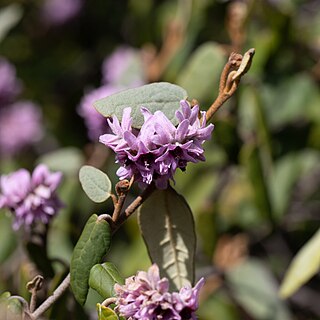
Lasiopetalum discolor, commonly known as coast velvet-bush, is a species of flowering plant in the family Malvaceae and is endemic to coastal areas of southern Australia. It is an erect, spreading or sprawling shrub with hairy stems, oblong to egg-shaped leaves and pink or white flowers.
Lasiopetalum membranaceum is a species of flowering plant in the family Malvaceae and is endemic to near-coastal areas of south-western Western Australia. It is an erect, spreading shrub or subshrub with hairy young stems, egg-shaped leaves and mauve-pink and dark red flowers.
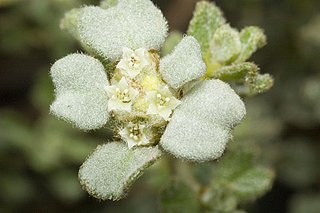
Spyridium halmaturinum, commonly known as Kangaroo Island spyridium, is a species of flowering plant in the family Rhamnaceae and is endemic to Kangaroo Island in South Australia. It is an erect, sticky shrub with densely softly-hairy young stems, leaves that are heart-shaped with the narrower end towards the base to broadly wedge-shaped or Y-shaped, and dense heads of white to cream-coloured flowers.
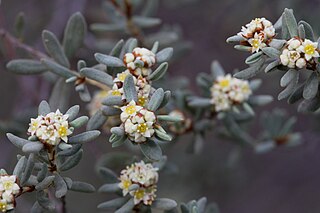
Spyridium subochreatum is a species of flowering plant in the family Rhamnaceae and is endemic to southern continental Australia. It is a low shrub with linear to oblong or narrowly egg-shaped leaves, and dense clusters of creamy-white flowers with dark brown, papery bracts at the base.


















